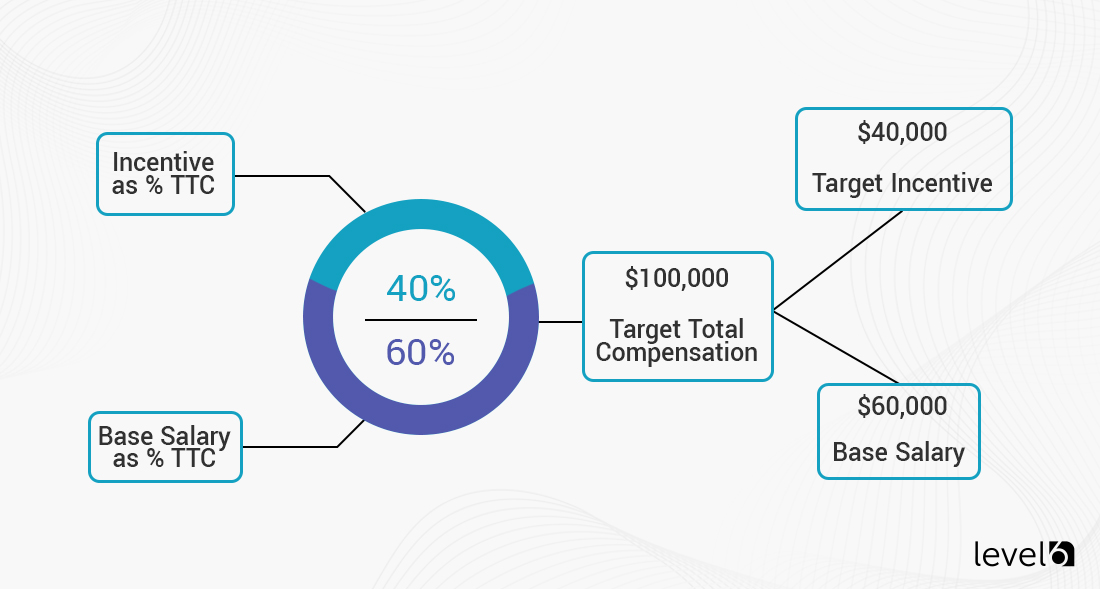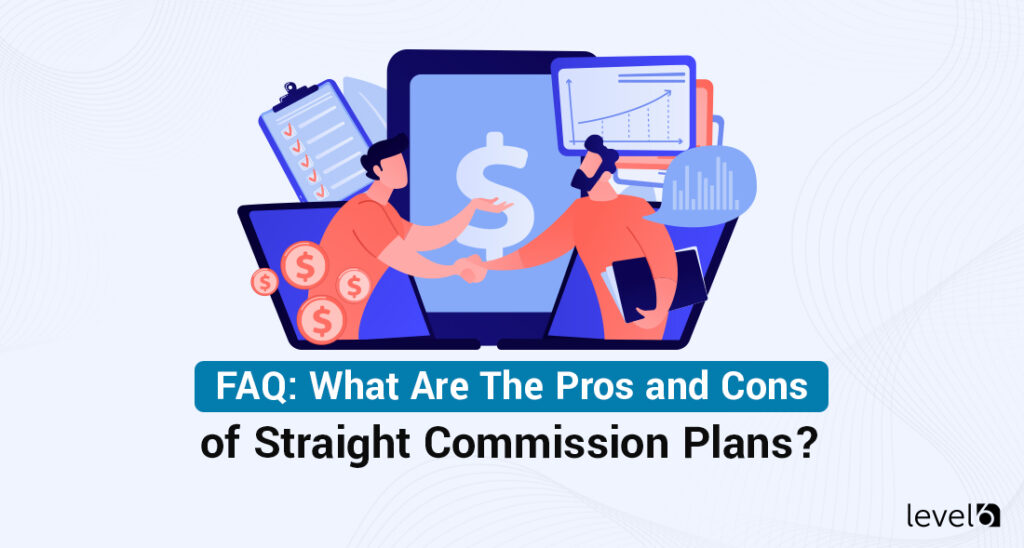The “on-target earnings” (OTE) model is an increasingly popular sales model that has been adopted by many organizations.
OTE is an attractive model for sales reps because it allows them to easily calculate their base salary based on achieving their designated quota.
The OTE is calculated based on the quota or target number the sales rep needs to reach to receive the designated salary. OTE models are designed to incentivize sales reps to exceed their goals and drive sales.
It considers a salesperson’s overall performance, including individual and team quotas, monthly or annual sales figures, and any additional incentives. The model then determines their base salary if they reach 100% of their quota. This salary figure is usually an annual number rather than a monthly or weekly one.
OTEs can also vary depending on the type of industry, job title, and company size. Sales reps need to understand the specifics of the OTE model at their company before setting any targets.
Benefits of the On-Target Earnings Sales Model
The on-target earnings sales model offers several advantages for sales teams and organizations.
The primary benefit of the OTE model is that it provides sales reps with a clear target, straightforward, and measurable goal that is easy to track and report on. It also eliminates any confusion or discrepancies in the commission calculations since there is one consistent number to work with.
Second, it incentivizes reps to perform their best, as they know their success will be rewarded accordingly. This model gives reps a clear goal to strive for, which can help foster a strong sense of competition and ambition.
OTE is an attractive option for employers because it encourages employees to maximize their sales performance. Furthermore, it allows companies to establish performance benchmarks and measure their sales teams’ success.
Looking to learn more about an incentive, rebate
or reward program for your business?
Curious about costs?
Try our instant pricing calculator:
It provides organizations with a reliable way to accurately forecast their expected sales performance. Having a specific number to target makes it easier to manage resources and develop accurate projections. This can help ensure that everyone involved is on the same page.
It’s also an efficient way to pay out commissions. Since the payout structure is predetermined, it eliminates the need for extensive calculations and ensures reps promptly receive what they’re due.
The on-target earnings sales model can help get all organizational departments on the same page regarding revenue and expenses. It requires collaboration between human resources, the sales department, accounting, and the company’s leadership to set reasonable OTE goals.
Drawbacks of the On-Target Earnings Sales Model
The on-target earnings sales model does have a few drawbacks that should be considered before implementing it. First, it assumes that sales reps can easily achieve their quotas, which may only sometimes be the case.
It also creates an environment where sales reps are driven to reach their goals and can become overly competitive with one another. Additionally, sales reps may only receive the expected salary if they hit their targets.
The OTE can lead to sales reps feeling pressured to meet unrealistic targets. With proper support and guidance, they may focus more on achieving the target and pay attention to other important aspects of their job.
It can also lead to dissatisfaction and burnout if not managed properly. For example, if quotas are too high or unrealistic, it can lead to frustration and decreased motivation among sales staff. As such, employers should ensure that quotas are reasonable and attainable to get the most out of the OTE model.
This model doesn’t consider any bonuses or commissions that a sales rep might earn beyond their quota. Recruiters and administrators in sales commissions may find that calculating an employee’s on-target earnings (OTE) can be challenging.
First, it requires them to clearly understand the sales commission structure and each employee’s quota. Without this information, it can be difficult to accurately calculate the OTE.
Additionally, recruiters and administrators must ensure that each employee is properly incentivized, so they don’t miss out on any potential earnings. This means taking into account any additional bonuses or other incentive plans to ensure the OTE is accurate.
Recruiters and administrators must also stay up-to-date on changes to the sales commission structure. If any factors used to calculate OTE are altered, the entire process must be reevaluated to ensure the figure’s accuracy.
Ultimately, calculating OTE is a complex process that can be difficult to manage without an effective strategy. Recruiters and administrators must thoroughly understand their sales commission structure and incentive plans and a system for keeping track of any changes.
How On-Target Earnings are Calculated
As we just mentioned, OTE is calculated by taking the total expected earnings of a rep for the year, divided by the total number of quotas that must be met to earn it.
For example, let’s say a company sets an annual OTE target of $100,000. To calculate the OTE, the company will divide the target figure by the number of quotas or goals that need to be met in order to reach the OTE.
If each quota is worth $10,000, then the rep must hit ten quotas to reach the $100,000 OTE.
OTE can also be calculated based on performance. If a rep exceeds the set quotas, they may be eligible for an additional bonus or commission on top of their OTE. Likewise, if a rep fails to meet their targets, their OTE may be adjusted accordingly.
OTEs can also be calculated as follows:
- Fixed payments
- Special commission percentages
- Some mix of both
It’s generally a good idea to base your OTEs on around 20% of your total annual quota. Or you could base your sales commission structure on approximately six to seven times the total sales quota.
Factors determining which calculation model works best for your company depend on your “unique industry, how experienced your sales representatives are, your management teams, your unique sales process, revenue, sales role popularity, and much more.”
Everstage offers this advice for calculating OTE for sales:
- Establish your employee’s base salary by considering their position and the amount of work they do.
- Finalize your sales quota in a balanced way — it shouldn’t be so high as to be unattainable, but it should still be challenging.
- Align your commissions with your goals. Are you looking for increased monthly revenues, or are you looking to close more deals within a specified timeframe?
- Add the base salary and commission percentages together to determine the total payment.
They also suggest considering the employee’s position, the length of your sales cycle, and the complexity of your product to determine your precise OTE.
Overall, the On-Target Earnings sales model provides reps with a clear understanding of their expected income for the year and how much effort they need to put in to reach it. It also allows companies to provide more accurate sales reps’ performance forecasts.
How to Use an On-Target Earnings Sales Model as Part of a Successful Sales Strategy
It’s also important to keep track of your team’s performance and measure it against the goals you have set. This can be done through various methods such as using analytical software, keeping scorecards, or holding regular meetings with each individual to check progress. Knowing how each rep performs will allow you to adjust goals as necessary and provide additional coaching and support.
In addition, an OTE model should be used in conjunction with other strategies to ensure a successful sales strategy. For example, providing incentives such as bonuses or commission rewards can motivate reps and encourage them to strive for higher performance levels. Additionally, ensuring your team is well-trained and has the right resources available can go a long way toward helping them reach their goals.
What is Pay Mix?
Pay mix is the base salary and commission ratio in an on-target earnings (OTE) sales model. Pay mix is important for sales teams because it helps to balance the incentive for performance and the reward for success.
The main benefits of pay mix include motivating sales reps to hit their targets, providing consistent cash flow, and ensuring transparency. Pay mix also creates a competitive environment where sales reps can be rewarded for exceeding expectations.
Pay mix can also attract and retain talented salespeople and help maintain a sustainable work environment. It is important to consider all of these factors when determining an appropriate pay mix.
When looking at pay mix, it is important to understand the role of base salary and commission. The base salary portion of the pay mix should cover expenses such as rent, food, car payments, and other basic necessities. The commission portion should be variable based on the individual’s performance. The combination of these two components will create an effective pay mix.
When determining a pay mix, it is important to consider the goals and objectives of your organization and how they will be affected by the chosen pay mix. Additionally, it is important to factor in any fluctuations in revenue, target changes, or industry trends. These considerations will help ensure that the pay mix aligns with your overall business strategy.
How Future Employees will Evaluate an OTE Sales Job Offer
When it comes to evaluating a sales job offer with an on-target earnings (OTE) structure, employees need to understand how their base salary and potential commission are calculated. This base salary will typically be based on the employee’s experience, qualifications, and expertise in the field, while the commission structure will depend on your company’s goals.
The OTE should include an estimated target figure that each employee must reach to earn the full commission rate. This means that employers should be able to answer questions so the employee can better understand the company’s expectations and how they can achieve those goals.
Employees need to understand how their performance is measured and how they are rewarded for their efforts. Employees should also be given information about any additional incentives or bonuses that can help boost their earnings.
Employees will also need to assess a job offer’s risk/reward ratio that includes an OTE structure. They should understand what risks are involved in achieving their target and ensure they are comfortable with that risk. In addition, they should consider any non-monetary benefits, such as flexible hours, vacation time, and other perks that could enhance the overall compensation package.
On-Target Earnings FAQs
Q: Do the on-target earnings include any overtime an employee works?
A: No, the on-target earnings (OTE) are usually based on an annual quota or figure, and it does not include any overtime an employee works. OTE is designed to represent what a sales rep could make if they managed to reach 100% of their target.
This does not take into account any extra hours that may be worked to try to meet their quota or exceed it. If a sales rep works additional hours beyond their contracted hours, then those extra hours should be calculated and paid separately from their OTE. Overtime rates will depend on the individual’s contract and the labor laws in their state.
Q: I’ve heard the term “Fully-Ramped OTE” — what does this mean?
A: The term “fully-ramped OTE” describes a sales rep’s potential earnings when they have successfully reached their goal. This means that the sales rep has not only reached the target quota but also achieved a steady increase in earnings over a period of time.
This type of ramp-up process is often seen in sales commission models, as the rep is encouraged to increase their earning capacity by working towards higher targets.
Fully-ramped OTE is a term used to describe a sales rep’s highest possible income level, taking into account the total quota they have achieved and any additional bonuses or commissions they have earned along the way. It is important to remember that this number is not necessarily a realistic goal for every sales rep but rather an idea of what could be achieved with maximum effort and dedication.
In other words, fully-ramped OTE is the highest possible income level a sales rep can achieve once all targets are met and bonuses are received. It represents the peak of a sales rep’s earning potential and is the ultimate goal for sales reps aiming to maximize their incomes.
Q: What is considered “good” on-target earnings?
A: What is considered “good on-target earnings” can vary significantly from one organization to another, depending on factors such as the industry, the size of the sales force, the complexity of the products or services being sold, and the difficulty of achieving the sales goals.
Additionally, some organizations use performance-based incentives to incentivize their salespeople to exceed their targets, which can increase their overall OTE.
For most organizations, OTE is a critical metric when determining whether a salesperson is meeting their goals and providing value to the company. Generally speaking, an organization should aim for an OTE figure that is at least 25-50% higher than the base salary for their salespeople.
Salespeople are motivated and properly compensated for their effort to achieve their targets. Furthermore, it helps to ensure that the organization can attract and retain top-performing salespeople.
By focusing on developing Salesperson Incentives, Employee Recognition Rewards, Customer Loyalty Programs, and Rebate Programs, we at Level 6 can turn your ideas into reality. Let us help you put together the program that’s right for you, your employees, and your customers!

Claudine is the Chief Relationship Officer at Level 6. She holds a master’s degree in industrial/organizational psychology. Her experience includes working as a certified conflict mediator for the United States Postal Service, a human performance analyst for Accenture, an Academic Dean, and a College Director. She is currently an adjunct Professor of Psychology at Southern New Hampshire University. With over 20 years of experience, she joined Level 6 to guide clients seeking effective ways to change behavior and, ultimately, their bottom line.

 Demo
Demo






